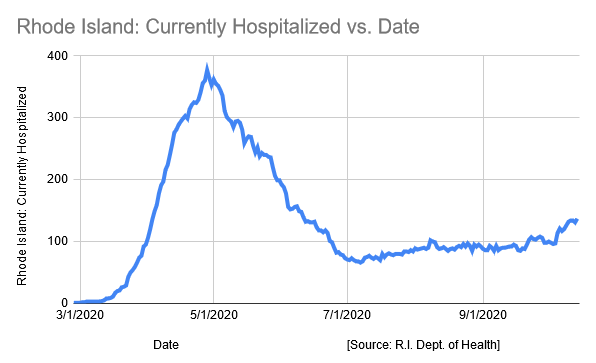Hospitalization Data: Why is Rhode Island Still Locked Down Five Months after Flattening the Curve?
Rhode Island leaders – Speaker Mattiello and Senate President Ruggerio lounging in the background; Governor Raimondo as point person – have chosen to prolong an onerous lockdown of the state due to COVID-19. The point person, at least, has repeatedly stated that her own decision to do so is guided by science and data.
But what, in fact, does perhaps the most important data point – hospitalizations – look like? “Perhaps the most important” because it was the sole reason for the lockdown – “15 days to flatten the curve” to not overwhelm hospitals.
In fact, Rhode Island’s hospitals have never been overwhelmed, not even at the peak, which occurred in late April. Nor, if you look at the graph, have we come close to peak since.
Let’s repeat that critically important point: Rhode Island’s hospitalization peak occurred in LATE APRIL and we haven’t come close to that number since. In fact, other than in hotspot New York months ago where it came close, hospitals were never overwhelmed anywhere in the United States.
Yet state leaders continue to keep Rhode Island locked down more than five months after we flattened the curve.
Late last week, the governor pointed to a recent modest uptick in cases and a “doubling” of hospitalizations in the last four weeks. Yes, the number per day of COVID-19 current hospitalizations is important to track. A “doubling” seems like a dramatic number and one that would seem to bolster her newer talking point that hospitals COULD get overwhelmed. But look at the graph. Even with this doubling, hospitalizations were less than half of the peak when she said this Thursday (“Currently Hospitalized” was 377 on April 28 vs 137 on October 14). And that number has already gone down, though not reflected in the graph; as of Saturday, we are at only one third of the hospitalizations of the peak (124 on October 17; down another 13).
To state the obvious, it is highly misguided, wasteful and an irresponsible abuse of power and resources for state leaders to implement policy – particularly such an impactful and damaging one – on the basis of something that COULD happen.
Conversely, lockdowns have severe consequences, especially in the medium and long term. And this is by far the biggest item that the governor – and, by proxy, the speaker and the senate president – is studiously disregarding, other than shallow, passing statements of acknowledgement, “I know it’s tough”, “lockdown fatigue”, “hang in there”, as she continues the economic strangulation of our state. Drug overdoses, suicides, deaths due to loss of medical insurance (alarming list here of unintended consequences of the lockdown). Add the destruction of people’s jobs, businesses, healthcare coverage, the economy and the tax base. Regarding that last item, state officials cling feverishly to federal money to solve the state’s severe budget woes (not entirely caused by the lockdown). But such an infusion is short term only and will not be there to make up for the medium and long term revenue that our state officials are destroying via the lockdown.
Even the World Health Organization recently deprecated lockdowns as a primary means of controlling COVID-19.
We need to be sure to mention the other important COVID-19 data point that is carefully omitted from our state leaders’ remarks and actions: the survival rate; well over 99%. And those who are most susceptible to the disease have been identified – a while ago, in fact – so can take steps to protect themselves.
The graph of hospitalizations is plain. Rhode Island’s lockdown is in no way justified by the data of its sole goal. Why didn’t the lockdown end months ago?
Monique is a political gadfly, data junkie and contributor to the Ocean State Current and Anchor Rising. Please consider supporting the terrific work of the Rhode Island Center for Freedom and Prosperity here:
https://secure.piryx.com/donate/7rkChZKP/RI-Center-for-Freedom-and-Prosperity/




